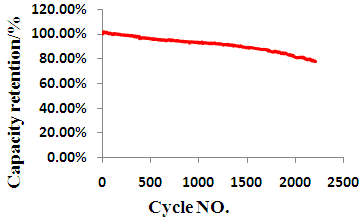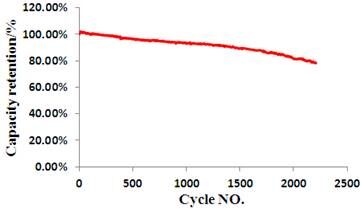Shenzhen Topband Battery Co., Ltd |
|
Environment - Friendly LiFePO4 Battery Cells Low Self - Discharge Lithium Iron Phosphate
· long life & deep cycle( over 2000cycles @ 100%DOD)
· with built-in PCM/BMS protection
· super quick charge/discharge performance
· safe pressure valve design ( no explosion, no fire)
· high energy density
· low self-discharge( <3% per month,<15% per year)
· 1/3 weight & 1/2 volume of lead acid battery
· eco-friendly
· high consistency
· no memory effect
· easily replace lead acid battery
| Lead acide battery VS. Topband LiFePO4 battery | |||
| Item | Lead acid battery | LiFePO4 battery | Comparison results |
| wh/kg | 30-45 | 100-150 | LiFePO4 battery is 1/3 weight of lead acid battery |
| wh/L | 60-80 | 200-250 | LiFePO4 battery is 1/2 volume of lead acid battery |
| conclusion 1 | LiFePO4 battery has higher energy density than that of lead acid battery. | ||
| cycle life | 300-500cycles | 2000cycles @80% DOD 1500cycles @100% DOD | LiFePO4 battery's life cycle is 5times of that of lead acid battery, and more cycles at deep discharge |
| conclusion 2 | LiFePO4 battery has much better cycle life. | ||
| charge rate | ≤0.3C | 0.5-1C | LiFePO4 battery can bare quick charge, eg., 2hs full charge for LiFePO4 battery, while more than 6hs for lead acid battery. |
| discharge rate | 3-5C,only 30%-40% capacity release under 3C discharge | 3-10C, 80%-90% capacity release under 3C discharge | LiFePO4 battery support high rate discharge, and more capcity release under high rate discharge |
| conclusion 3 | LiFePO4 battery has higher charge & discharge rate. | ||
| self-discharge rate | 3-10% | <1.5% | lead acid battery will be useless for long time storage, LiFePO4 battery can stock for long time |
| conclusion 4 | LiFePO4 battery has lower self-discharge rate. | ||
| pollution | Pb( against Rohs) | N/A | |
| conclusion 5 | LiFePO4 is more eco-friendly. | ||
| maitenance | need fill water constantly | free maitenance | |
| conclusion 6 | LiFePO4 need no maitenance. | ||
| protection | NA | BMS | |
| conclusion 7 | LiFePO4 has built in BMS for better control. | ||
| optional feature | bluetooth connection | Topband LiFePO4 allow users read battery info. | |
| conclusion 8 | Topband LiFePO4 support bluetooth connection. | ||
| warranty | 12-18months | 24months | |
| conclusion 9 | Topband LiFePO4 has longer warranty. | ||
| price | higher (unit price/300cycels) | 15%~25% lower than SLA battery(unit price/2000cycles) | |
| conclusion 10 | LiFePO4 is more cost effective in long run. | ||
| Summary | LiFePO4 battery meets the trend of development | ||
| LiFePO4 battery is better than lead acid battery from different points of view. | |||
1. General
This Product Specification describes the technique requirements, test procedures and precaution notes of prismatic type Lithium iron phosphate rechargeable cell, manufactured by SHEN ZHEN TOPBAND New Energy Technology CO.,LTD.
| No. | item | standard | remark |
| 2.1 | Nominal Capacity | 25Ah | 25±5℃,1C discharge |
| 2.2 | Internal Impedance | ≤4mΩ | |
| 2.3 | Nominal Voltage | 3.2V | |
| 2.4 | Cell Weight | 650±20g | |
| 2.5 | End-of-charge Voltage | 3.65V | At CC mode |
| 2.6 | End-of-charge Current | 0.05C | At CV mode |
| 2.7 | End-of-discharge Voltage | 2.00V | |
| 2.8 | Standard Charge Method | 1C CC/CV | 25±5℃ |
| 2.9 | Max pulse Discharge Current | 5C | Continuous Discharge Time: 10 seconds |
| 2.10 | Cycle Life | ≥2000cycles | 1C Continual Discharge: ≥80% (100% DOD) |
| 2.11 | Calendar life | 8years | |
| 2.12 | Charging Temperature | 0~45℃ | |
| 2.13 | Discharging Temperature | -20~55℃ | |
| 2.14 | Storage Temperature | -10~30℃ | |
| 2.15 | Pole torsion
| ≤5.5N·m | Lock nut is recommended |
| 2.16 | Appearance | Without break, scratch, distortion, contamination, leakage and so on | |
In ambient temperature of 25℃±5℃, 1C discharge the cell until the voltage drops to 2.0V, standby for one hour, then charge at a constant current of 1C until the voltage is 3.65V, then charge at a constant voltage of 3.65V until its current decreases to 0.05C, standby for one hour after charge.
| item | Criteria
| Test method | Charge & discharge curve |
4.1 High Temperature Discharge Performance
| Capacity retention at 55℃ :≥95% | A cell is charged in accordance with 3.2, and stored in high temperature chamber at 55℃for 5 h, then discharged to cut-off voltage at a constant current of 1C. After that, fetch out the cell and place it in the ambient temperature of 25℃±5℃ for 4 h, then check its appearance. |  |
4.2 Low Temperature Discharge Performance
| Capacity retention at -20℃ :≥70%
| A cell is charged in accordance with 3.2, and stored in certain ambient temperature for 24hours,then discharged to cut-off voltage(1.8V) at a constant current of 1C. After that , fetch out the cell and place it in the ambient temperature of 25℃±5℃for 4hours.
| |
4.3 Rate Charge Performance in Normal Temperature
| 2C charge capacity≥80%
| Under the ambient temperature of 25℃±5℃, a, 1C constant discharge till the cut-off voltage, standby for 1h; b, charge at certain current till 3.65V, standby for 1h; c, constant discharge with 1C current till 2.0V. |  |
4.4 Rate Discharge Performance in Normal Temperature
| 3C discharge capacity≥95%
| A cell is charged in accordance with 3.2, then discharged to cut-off voltage at certain current in an ambient temperature of 25℃±5℃.
|  |
4.5 Cycle Life (25℃±5℃)
| ≥2000cycles | A cell is 1C CC/CV 3.65V fully charged, after that stored for 30min; Subsequently, the cell is discharged to cut-off voltage at a constant current of 1C, and stored 30min prior to next charge-discharge cycle, until the capacity retention<80%, and record all the cycles
|  |




5. Environmental Characteristics
| No. | Item | Test Method
| Criteria
|
| 5.1 | Temperature shock test | A cell is charged in accordance with 3.2, and then repeat the following procedures for 5 cycles, then check the cell's appearance.
| No leakage, no fire, no explosion, no vent |
| 5.2 | Low-pressure Test
| A cell is charged in accordance with 3.2, then stored for 6h at a vacuum of -90KPa, after that put the cell in room temperature for 6h, then check the cell's appearance.
| No leakage, no fire, no explosion, no vent |
| 5.3 | Vibration Test | A cell is charged in accordance with 3.2, and then installed onto the vibration desk with clamps. Equipment parameters of frequency and amplitude are set as bellow (the frequency is to be varied at the rate of 1oct/min between 10 and 55 Hz, and repeat vibration for 30 min. The cell is tested in three mutually perpendicular directions, i.e. X,Y,Z): (a) frequency:10Hz~30Hz, amplitude: 0.38mm; (b) frequency:30Hz~55Hz amplitude: 0.19mm | 1.No scratch, no fire, no explosion, no vent; 2.The voltage is not less than 3.2V. |
| 5.4 | Shock Test
| A cell is tested in accordance with 3.2, and then secured to the testing machine by means of rigid mount which supports all mounting surfaces of the cell. Each cell shall be subjected to a total of three shocks of equal magnitude. The shocks are to be applied in each of three mutually perpendicular directions. The acceleration and impulse time are as follows: acceleration of impulse peak value:100m/s2, shock frequency:40~80 times/min, impulse lasting time:16 min,shock times:1000±10
| 1.No scratch, no leakage, no fire, no explosion, no vent; 2.the voltage is not less than 3.2V.
|
All below tests are carried out on the equipment with forced ventilation and explosion-proof device. Before test, all cells are charged in accordance with 3.2, and stored 24h prior to test.
| No. | Item | Test Method
| Criteria
|
| 6.1 | Short- circuit Test | A cell is tested in accordance with 3.2, after that the cell is short-circuited by connecting the positive and negative terminals with a wire for 10min, the wire has a maximum resistance load of 5mΩ., then observe for 1h. | No fire, no explosion |
| 6.2 | Overcharge Test
| A cell is tested in accordance with 3.2, then 1C constant current charged till the voltage reaches 1.5 times of the specified end-off charge voltage, or the charge time reaches 1h, then stop charge, and observe for 1h. | No fire, no explosion
|
| 6.3 | Over discharge test | A cell is tested in accordance with 3.2, then 1C discharge for 90min, then observe for 1h. | No fire, no explosion, no leakage |
| 6.4 | Crush Test | A cell is tested in accordance with 3.2, and then is placed on the crush flat, the axis is parallel to the crush flat, and it is crushed between two flat surfaces till the crushing force is gradually approaching 200 kN, or voltage reaches 0V,or reaches 30% distortion, then observe for 1h. | No fire, no explosion |
| 6.5 | Impact Test
| A cell is tested in accordance with 3.2, and then placed on the impact flat. A Φ15.8mm bar is to be placed on the center of the cell. A 9.1kg weight is dropped from a height of 610mm onto the cell, the distortion is allowed. | No fire, no explosion |
| 6.6 | nail penetration Test
| a) A cell is tested in accordance with 3.2; b) use φ5mm~φ8mm high temperature resistance steel needle, with speed of 25±5mm/s, to go through the cell from vertical direction of pole plate, the penetrate position should be close to the geometric center of plate surface, the steel needle remains in the cell; c)observe for 1h. | No fire, no explosion |
| 6.7 | Heating Test(130℃) | A cell is tested in accordance with 3.2, and then heated in a circulating air oven. The temperature of the oven is raised at a rate of 5℃ per minute to 130℃±3℃ and remain for 30 min. | No fire, no explosion |

